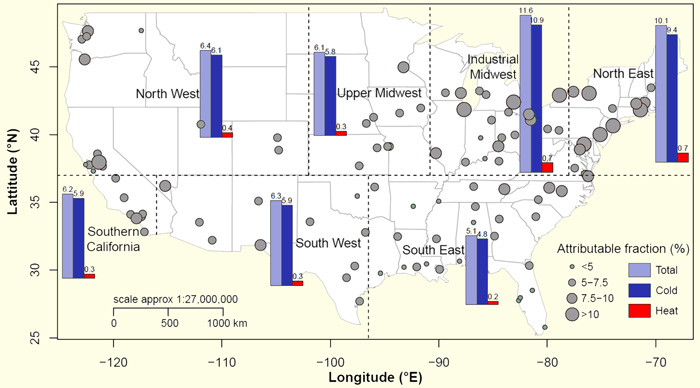| Tweet | Follow @co2science |
Paper Reviewed
Zhang, Y., Xiang, Q., Yu, Y., Zhan, Z., Hu, K. and Ding, Z. 2019. Socio-geographic disparity in cardiorespiratory mortality burden attributable to ambient temperature in the United States. Environmental Science and Pollution Research 26: 694-705.
Over the past couple of decades research has confirmed that temperature-related human mortality is generally much greater at the cold end of the temperature spectrum than at the warm end, i.e., cold spells are much more deadly than heat waves (see the multitude of reviews we have posted on studies that confirm this fact under the subheadings of Mortality in our Subject Index). The latest work added to this ever-growing mountain of evidence is that of Zhang et al. (2019).
Using climate and mortality data from 106 urban communities located across the continental United States, the six scientists calculate the attributable fraction of cardiorespiratory mortality due to ambient temperature over the period 1987-2000. This was accomplished by applying a quasi-Poisson regression with a distributed lag nonlinear model to the data to estimate locational-specific temperature/cardiorespiratory mortality associations. Then, the authors pooled these associations into seven regional and one national estimate via multivariate meta-analysis.
And what did the analysis reveal?
In the words of the authors, "for all communities, cold weather accounted for the most majority (89-99%) of the total temperature-attributable [mortality] burden." Nationally, the fraction of cardiorespiratory deaths caused by cold weather was 7.15%, whereas for warm weather it was only a paltry 0.43%. Thus, the mortality effects of cold weather were more than 16 times higher than that due to warm weather. The regional attributable fraction percentages were similar to that observed for the national average and are shown in the figure below.
Summing up their findings, Zhang et al. conclude that, "despite some regional differences in estimates of attributable fraction, cold weather was consistently found to be responsible for the most majority of temperature-related mortality burden." And, thus, once again new research confirms that it is cold temperatures about which society should be concerned. A little global warming would likely go a long way in producing a net saving of human lives!

Figure 1. Fractions of cardiovascular mortality attributable to ambient temperatures by communities and regions over the period 1987-2000. Source: Zhang et al. (2019).




